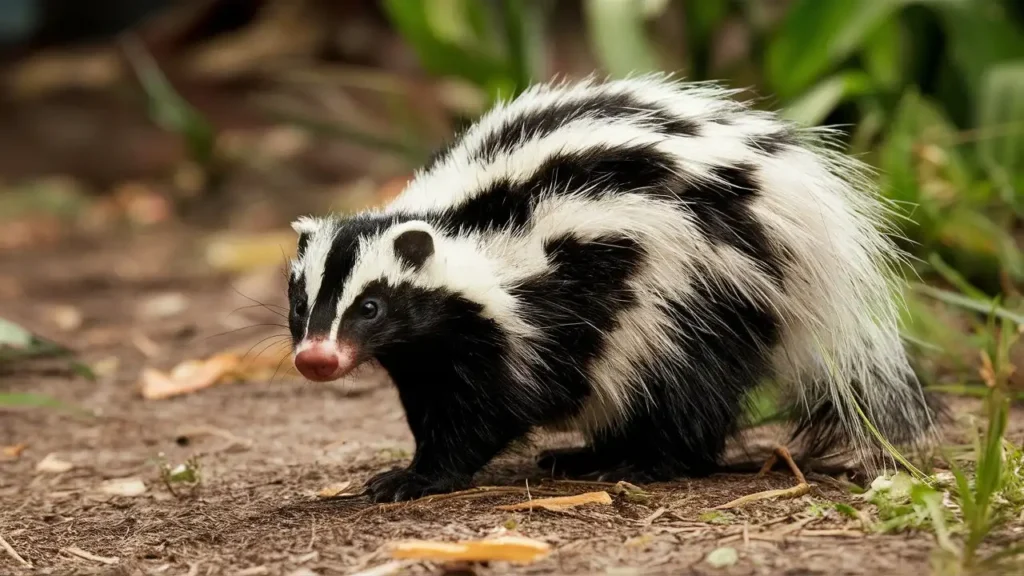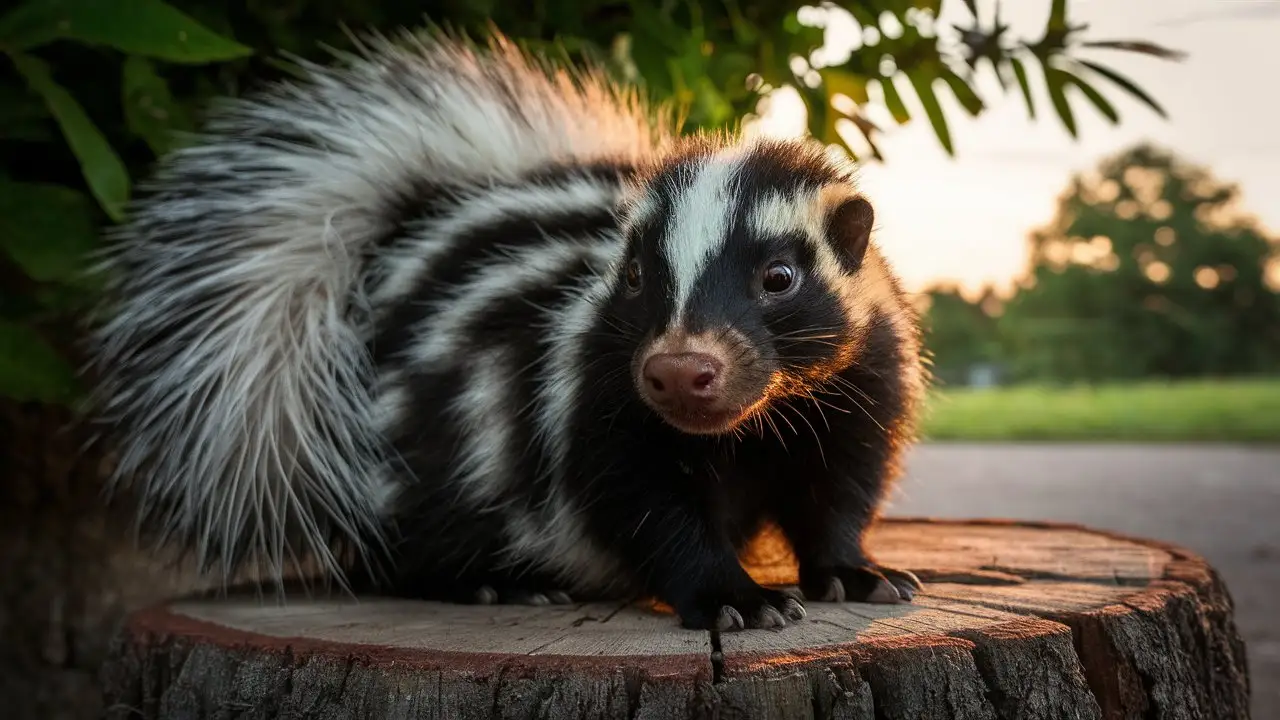Eastern Spotted Skunk: Diet & Habitat Explained
Last updated on March 7th, 2025 at 10:27 pm
Eastern SpoThe Eastern Spotted Skunk is a small, secretive carnivore native to various landscapes across the United States. Distinguished by its intricate black-and-white spotted patterns and unique defensive behaviors, this nocturnal creature plays a valuable role in controlling insect and rodent populations. Understanding its habitat, diet, and behaviors helps foster appreciation and inform conservation efforts aimed at preserving the subtle balance it maintains within ecosystems.
Appearance and Characteristics
Distinctive Features:
The Eastern Spotted Skunk is notably smaller than its more familiar striped cousin. Its body is sleek and flexible, allowing it to perform surprising acrobatics—most famously, the handstand posture it assumes when threatened. This display serves as a warning before resorting to its potent, foul-smelling spray.
Size and Weight:
- Length: Typically 18 to 30 inches (including tail)
- Weight: Between 14 ounces and 2.2 pounds
Despite their petite stature, these skunks are resilient survivors, well-suited to their environments.
Coloration:
Unlike striped skunks, the Eastern Spotted Skunk features complex patterns of white spots and irregular stripes on a glossy black coat. Two symmetrical stripes often merge at the head, and irregular white patches break up the skunk’s outline. This coloration helps with camouflage and signal communication, especially during nocturnal forays.
Habitat and Distribution
Geographical Range:
The Eastern Spotted Skunk’s range spans much of the central and southeastern United States, extending into parts of Canada and northern Mexico. Although once more common, their numbers have decreased in some regions.
Preferred Habitats:
They inhabit a mix of environments, including:
- Woodlands: Dense forests provide cover and abundant prey.
- Grasslands and Prairies: Open fields make hunting insects and small mammals easier.
- Brushy Areas and Farmlands: Edges and transitional zones offer shelter and foraging opportunities.
This adaptability to diverse habitats underlines their resilience, yet habitat loss and changes in land use patterns continue to pose challenges.
Diet and Feeding Behaviors
Omnivorous Diet:
Eastern Spotted Skunks are opportunistic feeders, relying on a wide array of foods to survive:
- Insects: Beetles, grasshoppers, and crickets.
- Small Vertebrates: Mice, voles, and occasionally birds or their eggs.
- Plant Matter: Fruits, berries, and other vegetation.
Foraging Habits:
As nocturnal hunters, they use their keen sense of smell to locate prey, often digging for insects or pouncing on rodents. Their varied diet allows them to exploit seasonal food resources and thrive in changing conditions.

Reproduction and Social Behavior
Mating and Breeding:
Mating season generally occurs in late winter to early spring. While typically solitary, Eastern Spotted Skunks briefly interact during this period. Males may travel extensively to find receptive females, engaging in brief courtship rituals.
Gestation and Offspring:
Females undergo a gestation period of about 50–65 days. Litters often consist of 4–5 kits born blind and helpless, usually in sheltered dens. The mother provides meticulous care, nursing and protecting them until they can fend for themselves.
Social Structure:
Outside of breeding and rearing young, Eastern Spotted Skunks are largely solitary. They communicate primarily through scent markings, vocalizations, and postural signals. This independent lifestyle reduces competition and resource conflict.
Defense Mechanisms
Renowned for their intense defense spray, Eastern Spotted Skunks first employ visual warnings before resorting to chemical deterrents. They perform a distinctive “handstand,” hind feet in the air, to appear larger and more intimidating. If the threat persists, they release a pungent musk from their anal glands—an odorous weapon that teaches predators to think twice before attacking again.
Threats and Conservation
Challenges:
The Eastern Spotted Skunk faces several threats:
- Habitat Loss and Fragmentation: Agriculture and development reduce suitable living spaces.
- Pesticide Use: Chemicals diminish insect prey and can harm skunks indirectly.
- Collisions with Vehicles: Roads bisect habitats, increasing mortality risks.
- Historical Hunting and Trapping: Although less common now, it affected populations.
Conservation Efforts:
Wildlife agencies and researchers aim to better understand spotted skunk populations through:
- Habitat restoration and protection.
- Research on population trends and distribution.
- Public education to reduce unnecessary conflicts.
Some regions list the Eastern Spotted Skunk as threatened or endangered, prompting targeted conservation measures.
Eastern Spotted Skunk Facts
- Acrobatics: Can perform handstands as a warning display.
- Dietary Benefit: As predators of insects and small rodents, they help control agricultural pests.
- Lifespan: In the wild, around 2–4 years, though some individuals can live longer in captivity.
- Cultural Myths: Stories and legends sometimes cast the skunk as a trickster or symbol of transformation.
Frequently Asked Questions
Q: What do Eastern Spotted Skunks eat?
A: They consume insects, small mammals, birds, eggs, fruits, and other plant matter, adapting their diet based on availability.
Q: How long do Eastern Spotted Skunks live?
A: They typically live 2–4 years in the wild, though this can extend to nearly a decade under human care.
Q: How are they different from Striped Skunks?
A: Eastern Spotted Skunks are smaller, more agile, and feature complex spotted-white patterns instead of distinct stripes. They also display a unique handstand behavior before spraying.
Conclusion
The Eastern Spotted Skunk is a remarkable testament to nature’s adaptability and diversity. Its unique coloration, acrobatic defensive displays, and flexible diet all contribute to its role as both predator and prey within woodland and grassland ecosystems. By understanding their ecology and addressing the threats they face, we can ensure that these intriguing skunks continue to enrich North America’s natural heritage for generations to come.

